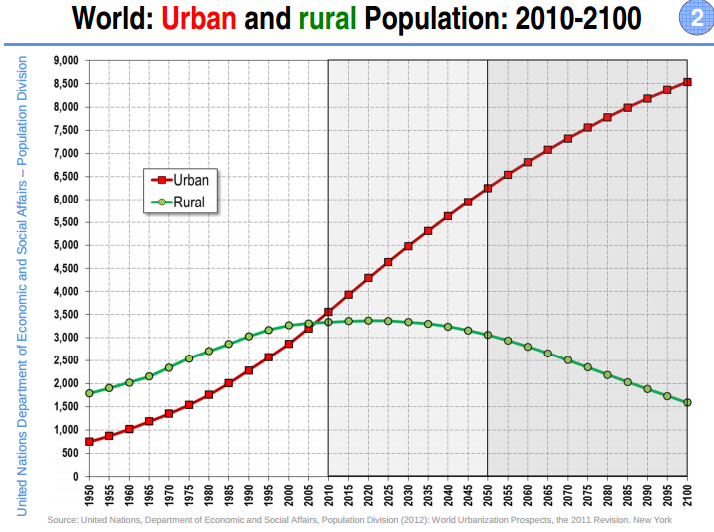The 2014 revision of the World Urbanization Prospects by UN DESA’s Population Division notes that the largest urban growth will take place in India, China and Nigeria. These three countries will account for 37 per cent of the projected growth of the world’s urban population between 2014 and 2050. By 2050, India is projected to add 404 million urban dwellers, China 292 million and Nigeria 212 million.
Today, 54 per cent of the world’s population lives in urban areas, a proportion that is expected to increase to 66 per cent by 2050. Projections show that urbanization combined with the overall growth of the world’s population could add another 2.5 billion people to urban populations by 2050, with close to 90 percent of the increase concentrated in Asia and Africa, according to the United Nations report.
Nextbigfuture thinks the world will be even more urban than the UN projections.
* Vehicle to vehicle communication and self driving cars can eliminate traffic jams
* Factory mass produced skyscrapers can lower the cost of buildings.
These kinds of technologies will lower the cost and the downsides of cities.
Mega-cities with more than 10 million people are increasing in number
The report notes that in 1990, there were ten “mega-cities” with 10 million inhabitants or more, which were home to 153 million people or slightly less than seven per cent of the global urban population at that time. In 2014, there are 28 mega-cities worldwide, home to 453 million people or about 12 percent of the world’s urban dwellers. Of today’s 28 mega-cities, sixteen are located in Asia, four in Latin America, three each in Africa and Europe, and two in Northern America. By 2030, the world is projected to have 41 mega-cities with 10 million inhabitants or more.
Tokyo remains the world’s largest city with 38 million inhabitants, followed by Delhi with 25 million, Shanghai with 23 million, and Mexico City, Mumbai and São Paulo, each with around 21 million inhabitants. Osaka has just over 20 million, followed by Beijing with slightly less than 20 million. The New York-Newark area and Cairo complete the top ten most populous urban areas with around 18.5 million inhabitants each.
Today, America is 82 urban, Europe is 78% urban and Latin America is 80% urban. So China will be at about todays European level of urbanization in 2050.
Small cities are numerous and many are growing rapidly
Overall, nearly half of the world’s 3.9 billion urban dwellers reside in relatively small settlements with fewer than 500,000 inhabitants, while only around one in eight live in the 28 mega-cities with 10 million inhabitants or more. Many of the fastest growing cities in the world are relatively small urban settlements.
Rural populations expected to decrease as urban populations continue to grow
The rural population of the world has grown slowly since 1950 and is expected to reach its peak around 2020. The global rural population is now close to 3.4 billion and is expected to decline to 3.1 billion by 2050.
If you liked this article, please give it a quick review on ycombinator or StumbleUpon. Thanks

Brian Wang is a Futurist Thought Leader and a popular Science blogger with 1 million readers per month. His blog Nextbigfuture.com is ranked #1 Science News Blog. It covers many disruptive technology and trends including Space, Robotics, Artificial Intelligence, Medicine, Anti-aging Biotechnology, and Nanotechnology.
Known for identifying cutting edge technologies, he is currently a Co-Founder of a startup and fundraiser for high potential early-stage companies. He is the Head of Research for Allocations for deep technology investments and an Angel Investor at Space Angels.
A frequent speaker at corporations, he has been a TEDx speaker, a Singularity University speaker and guest at numerous interviews for radio and podcasts. He is open to public speaking and advising engagements.




